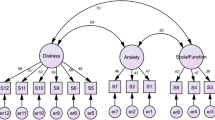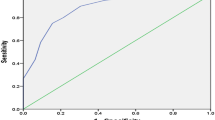Abstract
Background
The finding of variation in the optimal threshold of the General Health Questionnaire (GHQ) across different settings has proved difficult to explain. This analysis aimed to examine the optimal threshold of the GHQ, its variability and relationship with prevalence of psychiatric disorder.
Methods
A cross–sectional two–phase epidemiological survey was used in a study of non–psychotic psychiatric disorder of General Practice consulters. A total of 1670 consecutive patients were screened using the GHQ–28 and the GP encounter form, and 336 were interviewed using the Structured Clinical Interview for DSM-IV Axis I Disorders (SCID). The total prevalence of the psychiatric disorders was estimated using three different methods and was calculated in the rural and urban practices and among those attending the General Practitioners and Practice Nurses.
Results
The frequency distribution of the GHQ score for the whole sample of respondents was skewed resulting in the biased mean GHQ score. The mean values for different sample categories were found to be higher than the median values indicating that the median GHQ score may be a better parameter to describe the score distribution than the mean. The median value of the GHQ score showed a strong correlation with the prevalence estimated by the three different methods.
Conclusions
The median of GHQ score gives a better estimate for the cut–off score than the mean. The median score may be used as an estimate for the optimal threshold, in settings where the sensitivity and specificity are not known or where an estimate of the prevalence from a questionnaire survey is required. Alternative methods are preferable when screening for individual cases or in the context of a two–phase design.
Similar content being viewed by others
References
American Psychiatric Association (1995) Diagnostic and Statistical Manual of Mental Disorders 4th Edition. RR Donnelley & Sons Company, USA, p 886
Boardman AP (1987) The General Health Questionnaire and the detection of emotional disorder by general practitioners: A replicated study. Br J Psychiatry 151:373–381
Boardman AP, Henshaw CA, Willmott SA (2003) Mid Cheshire and Keele General Practice Study: I The prevalence of psychiatric disorders in general practice attenders. Submitted to the British Journal of Psychiatry
Clarke DM, McKenzie DP (1994) A caution on the use of cutpoints applied to screening instruments or diagnostic criteria. J Psychiatr Res 28(2):185–188
Dunn G, Pickles A, Tansella M, Vazquez-Barquero JL (1999) Twophase epidemiological surveys in psychiatric research. Br J Psychiatry 174:95–100
Finlay-Jones R, Brown GW, Duncan-Jones P, Harris T, Murphy E, Prudo R (1980) Depression and anxiety in the community: replicating the diagnosis of a case. Psychol Med 10:445–454
First MB, Spitzer RL, Gibbon M, Williams JBW (1996) Structured Clinical Interview of DSM-IV Axis I Disorders – Patient Edition (SCID-I/P, Version 2.0). Biometrics Research Department, New York State Psychiatric Institute. 722 West 168th Street, New York, NY 10032, USA
Furukawa TA, Goldberg DP (1999) Cultural invariance of likelihood ratios for the General Health Questionnaire. Lancet 353:561–562
Furukawa TA, Goldberg DP, Rabe-Hesketh S, Ustun TB (2001) Stratum-specific likelihood ratios of two versions of the General Health Questionnaire. Psychol Med 31:519–529
Goldberg DP (1972) The Detection of Psychiatric Illness by Questionnaire. Oxford University Press: London
Goldberg DP (1978) Manual of the General Health Questionnaire. NFER-NELSON Publishing Co. Ltd.,Windsor
Goldberg DP, Hillier VF (1979) A scaled version of the General Health Questionnaire. Psychol Med 9:139–145
Goldberg D, Huxley P (1980) Mental Illness in the Community. London: Tavistock
Goldberg DP, Oldehinkel T, Ormel J (1998) Why GHQ threshold varies from one place to another. Psychol Med 28:915–921
Gureje O, Obikoya B (1990) The GHQ-12 as a screening tool in a primary care setting. Soc Psychiatry Psychiatr Epidemiol 25:276–280
Lobo A, Perez-Echeverria MJ, Artal J (1986) Validity of the scaled version of the General Health Questionnaire (GHQ-28) in Spanish population. Psychol Med 16:135–140
Marks JN, Goldberg DP, Hillier VF (1979) Determinants of the ability of general practitioners to detect psychiatric illness. Psychol Med 9:337–353
Ormel J, Van Der Brink W, Koeter MWJ, Giel R, Van Der Meer K, Van De Willige G, Wilmink FW (1990) Recognition,management and outcome of psychological disorders in primary care: a naturalistic follow-up study. Psychol Med 20:909–923
Sackett DL, Straus SE, Richardson WS, Rosenburg W, Haynes RB (2000) Evidence-Based Medicine: How to Practice and Teach EBM. 2nd Edition. Edinburgh: Churchill Livingstone
Schmitz N, Kruse J, Tress W (1999) Psychometric properties of the General Health Questionnaire (GHQ-12) in a German primary care sample. Acta Psychiatr Scand 100:462–468
SPSS Inc. (1999) SPSS Software: Release 9.0. Chicago, IL 60611, USA
StataCorp. (1999) Stata Statistical Software: Release 6.0. College Station, Tx, USA
Van Hemert AM, Den Heijer M, Vorstenbosch M, Bolk JH (1995) Detecting psychiatric disorders in medical practice using the General Health Questionnaire. Why do cut-off scores vary? Psychol Med 25:165–170
Wilmink FW, Snijders TA (1989) Polytomous logistic regression analysis of the General Health Questionnaire and the Present State Examination. Psychol Med 19:755–764
Author information
Authors and Affiliations
Corresponding author
Rights and permissions
About this article
Cite this article
Willmott, S.A., Boardman, J.A.P., Henshaw, C.A. et al. Understanding General Health Questionnaire (GHQ–28) score and its threshold. Soc Psychiatry Psychiatr Epidemiol 39, 613–617 (2004). https://doi.org/10.1007/s00127-004-0801-1
Accepted:
Issue Date:
DOI: https://doi.org/10.1007/s00127-004-0801-1




